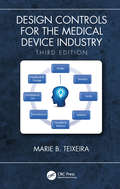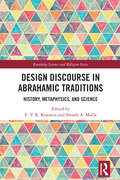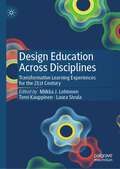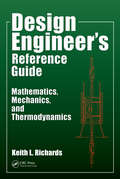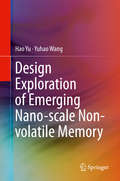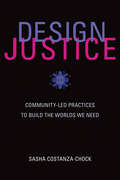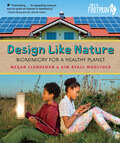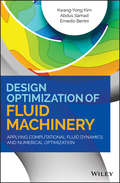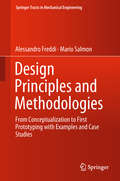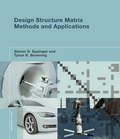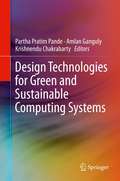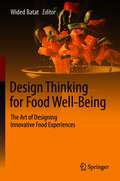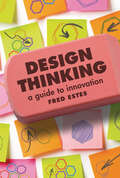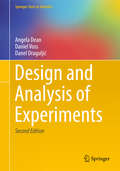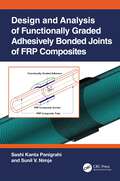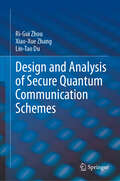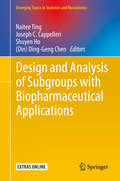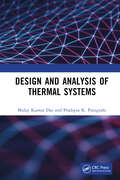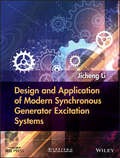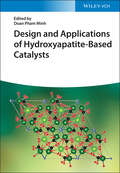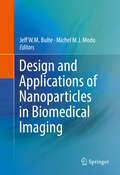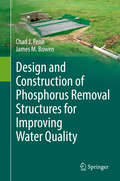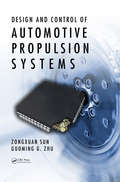- Table View
- List View
Design Controls for the Medical Device Industry, Third Edition
by Marie B. TeixeiraThis third edition provides a substantial comprehensive review of the latest design control requirements, as well as proven tools and techniques to ensure a company's design control program evolves in accordance with current industry practice. It assists in the development of an effective design control program that not only satisfies the US FDA Quality Systems Regulation (QSR) and 13485:2016 standards, but also meets today's Notified Body Auditors' and FDA Investigators' expectations. The book includes a review of the design control elements such as design planning, input, output, review, verification, validation, change, transfer, and history, as well as risk management inclusive of human factors and usability, biocompatibility, the FDA Quality System Inspection Technique (QSIT) for design controls, and medical device regulations and classes in the US, Canada, and Europe. Practical advice, methods and appendixes are provided to assist with implementation of a compliant design control program and extensive references are provided for further study. This third edition: Examines new coverage of ISO 13485-2016 design control requirements Explores proven techniques and methods for compliance Contributes fresh templates for practical implementation Provides updated chapters with additional details for greater understanding and compliance Offers an easy to understand breakdown of design control requirements Reference to MDSAP design control requirements
Design Discourse in Abrahamic Traditions: History, Metaphysics, and Science (Routledge Science and Religion Series)
by E. V. R. Kojonen Shoaib A. MalikDesign Discourse in Abrahamic Traditions reconnects discussion of design arguments to its Jewish, Christian, and Muslim history. The ancient idea that there is evidence of purpose in nature remains one of the most debated topics in science and religion, but also one with great potential for inter-religious and interdisciplinary dialogue. This volume revitalizes current discussion by retrieving perspectives from the Abrahamic history of design arguments and engaging them with contemporary ideas. Beginning with the encounter ancient philosophy and creation beliefs, the book proceeds to delve deep into issues ranging from the nature of theological and teleological language to the implications of evolution and evil. This rich exploration showcases how, far from being irrelevant in a post-Humean, post-Darwinian world, design arguments continue to merit both popular-level and academic attention. The volume will be of particular interest to scholars working at the intersection of science and religion, philosophers of religion, and theologians.
Design Education Across Disciplines: Transformative Learning Experiences for the 21st Century
by Miikka J. Lehtonen Tomi Kauppinen Laura SivulaThis book explores how design thinking can transform higher education, with solutions ranging from single course sessions to whole programs and universities. The authors demonstrate how designing across disciplines is done, with disruptive technologies, ambiguity and challenges as catalysts. Iteratively tested pedagogies, design-driven solutions and creative uses of both tactile and digital worlds are among the approaches discussed. Educators and leaders of higher education institutes as well as designers and managers of companies will benefit from engaging the design ideas in their own work.
Design Engineer's Reference Guide: Mathematics, Mechanics, and Thermodynamics
by Keith L. RichardsAuthor Keith L. Richards believes that design engineers spend only a small fraction of time actually designing and drawing, and the remainder of their time finding relevant design information for a specific method or problem. He draws on his own experience as a mechanical engineering designer to offer assistance to other practicing and student engi
Design Exploration of Emerging Nano-scale Non-volatile Memory
by Hao Yu Yuhao WangThis book presents the latest techniques for characterization, modeling and design for nano-scale non-volatile memory (NVM) devices. Coverage focuses on fundamental NVM device fabrication and characterization, internal state identification of memristic dynamics with physics modeling, NVM circuit design and hybrid NVM memory system design-space optimization. The authors discuss design methodologies for nano-scale NVM devices from a circuits/systems perspective, including the general foundations for the fundamental memristic dynamics in NVM devices. Coverage includes physical modeling, as well as the development of a platform to explore novel hybrid CMOS and NVM circuit and system design. * Offers readers a systematic and comprehensive treatment of emerging nano-scale non-volatile memory (NVM) devices; * Focuses on the internal state of NVM memristic dynamics, novel NVM readout and memory cell circuit design and hybrid NVM memory system optimization; * Provides both theoretical analysis and practical examples to illustrate design methodologies; * Illustrates design and analysis for recent developments in spin-toque-transfer, domain-wall racetrack and memristors.
Design Justice: Community-Led Practices to Build the Worlds We Need (Information Policy)
by Sasha Costanza-ChockAn exploration of how design might be led by marginalized communities, dismantle structural inequality, and advance collective liberation and ecological survival.What is the relationship between design, power, and social justice? “Design justice” is an approach to design that is led by marginalized communities and that aims expilcitly to challenge, rather than reproduce, structural inequalities. It has emerged from a growing community of designers in various fields who work closely with social movements and community-based organizations around the world.This book explores the theory and practice of design justice, demonstrates how universalist design principles and practices erase certain groups of people—specifically, those who are intersectionally disadvantaged or multiply burdened under the matrix of domination (white supremacist heteropatriarchy, ableism, capitalism, and settler colonialism)—and invites readers to “build a better world, a world where many worlds fit; linked worlds of collective liberation and ecological sustainability.” Along the way, the book documents a multitude of real-world community-led design practices, each grounded in a particular social movement. Design Justice goes beyond recent calls for design for good, user-centered design, and employment diversity in the technology and design professions; it connects design to larger struggles for collective liberation and ecological survival.
Design Like Nature: Biomimicry for a Healthy Planet (Orca Footprints #20)
by Megan Clendenan Kim Ryall Woolcock★“Fascinating…An appealing resource sure to spark an interest in biomimicry, from casual readers to budding scientists. Recommended for all libraries.”—School Library Journal, starred review Did you know that lamps can be powered by glowing bacteria instead of electricity? That gloves designed like gecko feet let people climb straight up glass walls? Or that kids are finding ways to make compostable plastic out of banana peels? Biomimicry, the scientific term for when we learn from and copy nature, is a revolutionary way to look to nature for answers to environmental problems such as climate change. In Design Like Nature young readers discover innovations and inventions inspired by the environment. Nature runs the entire planet with no waste and no pollution. Can humans learn to do this too? It's time to step outside and start designing like nature.
Design Optimization of Fluid Machinery: Applying Computational Fluid Dynamics and Numerical Optimization
by Abdus Samad Kwang-Yong Kim Ernesto BeniniDesign Optimization of Fluid Machinery: Applying Computational Fluid Dynamics and Numerical Optimization Drawing on extensive research and experience, this timely reference brings together numerical optimization methods for fluid machinery and its key industrial applications. It logically lays out the context required to understand computational fluid dynamics by introducing the basics of fluid mechanics, fluid machines and their components. Readers are then introduced to single and multi-objective optimization methods, automated optimization, surrogate models, and evolutionary algorithms. Finally, design approaches and applications in the areas of pumps, turbines, compressors, and other fluid machinery systems are clearly explained, with special emphasis on renewable energy systems. Written by an international team of leading experts in the field Brings together optimization methods using computational fluid dynamics for fluid machinery in one handy reference Features industrially important applications, with key sections on renewable energy systems Design Optimization of Fluid Machinery is an essential guide for graduate students, researchers, engineers working in fluid machinery and its optimization methods. It is a comprehensive reference text for advanced students in mechanical engineering and related fields of fluid dynamics and aerospace engineering.
Design Principles and Methodologies: From Conceptualization to First Prototyping with Examples and Case Studies (Springer Tracts in Mechanical Engineering)
by Alessandro Freddi Mario SalmonThis book introduces readers to the core principles and methodologies of product development, and highlights the interactions between engineering design and industrial design. It shows to what extent the two cultures can be reconciled, and conversely what makes each of them unique. Although the semantic aspect is fundamental in industrial design, while the functional aspect is essential for the industrial product, the interaction between the two worlds is strategically vital. Design is also a strategic problem-solving process that drives innovation, builds business success and leads to better quality of life through innovative products, systems, services and experiences. The book connects product development with the concepts and strategies of innovation, recognizing that product design is a complex process in which invention, consumers’ role, industrial technologies, economics and the social sciences converge. After presenting several examples of artifacts developed up to the conceptual phase or built as prototypes, the book provides a case study on a packaging machine, showcasing the principles that should underlie all design activities, and the methods that must be employed to successfully establish a design process. The book is primarily targeted at professionals in the industry, design engineers and industrial designers, as well as researchers and students in design schools, though it will also benefit any reader interested in product design.
Design Structure Matrix Methods and Applications (Engineering Systems)
by Steven D. Eppinger Tyson R. BrowningAn introduction to a powerful and flexible network modeling tool for developing and understanding complex systems, with many examples from a range of industries.Design structure matrix (DSM) is a straightforward and flexible modeling technique that can be used for designing, developing, and managing complex systems. DSM offers network modeling tools that represent the elements of a system and their interactions, thereby highlighting the system's architecture (or designed structure). Its advantages include compact format, visual nature, intuitive representation, powerful analytical capacity, and flexibility. Used primarily so far in the area of engineering management, DSM is increasingly being applied to complex issues in health care management, financial systems, public policy, natural sciences, and social systems. This book offers a clear and concise explanation of DSM methods for practitioners and researchers.
Design Technologies for Green and Sustainable Computing Systems
by Krishnendu Chakrabarty Amlan Ganguly Partha Pratim PandeThis book provides a comprehensive guide to the design of sustainable and green computing systems (GSC). Coverage includes important breakthroughs in various aspects of GSC, including multi-core architectures, interconnection technology, data centers, high performance computing (HPC), and sensor networks. The authors address the challenges of power efficiency and sustainability in various contexts, including system design, computer architecture, programming languages, compilers and networking.
Design Thinking for Every Classroom: A Practical Guide for Educators
by Shelley Goldman Molly B. ZielezinskiDesigned to apply across grade levels, Design Thinking for Every Classroom is the definitive teacher’s guide to learning about and working with design thinking. Addressing the common hurdles and pain points, this guide illustrates how to bring collaborative, equitable, and empathetic practices into your teaching. Learn about the innovative processes and mindsets of design thinking, how it differs from what you already do in your classroom, and steps for integrating design thinking into your own curriculum. Featuring vignettes from design thinking classrooms alongside sample lessons, assessments and starter activities, this practical resource is essential reading as you introduce design thinking into your classroom, program, or community.
Design Thinking for Food Well-Being: The Art of Designing Innovative Food Experiences
by Wided BatatHow can we design innovative food experiences that enhance food pleasure and consumer well-being? Through a wide variety of empirical, methodological, and theoretical contributions, which examine the art of designing innovative food experiences, this edited book explores the relationship between design thinking, food experience, and food well-being. While many aspects of food innovation are focused on products' features, in this book, design thinking follows an experiential perspective to create a new food innovation design logic that integrates two aspects: consumer food well-being and the experiential pleasure of food. It integrates a holistic perspective to understand how designing innovative food experiences, instead of food products, can promote healthy and pleasurable eating behaviors among consumers and help them achieve their food well-being. Invaluable for scholars, food industry professionals, design thinkers, students, and amateurs alike, this book will define the field of food innovation for years to come.
Design Thinking: A Guide to Innovation
by Fred EstesDesign thinking is a six-step process used in creative problem solving to understand users, challenge assumptions, redefine problems, and create innovative solutions. As a human-centered approach to innovation, design thinking is used in everything from corporate structure in businesses such as UberEATS, AirBnB, and Adobe XD to local and regional projects. Design Thinking, by author and educator Fred Estes, provides a simple, clear approach to the six-step design thinking process. This easy-to-follow guide explains everything essential to design thinking projects focused on solving human-centered, social issues. Readers will learn the fundamentals of each of the six-steps in the design thinking model—notice and reflect, empathize, define, ideate, prototype, and test—and discover how to collaborate with people to develop solutions to real-world problems and create better communities through creativity, inspiration, and teamwork. With true stories of real student teams and their projects, this book provides readers with the steps to effect change and create a more equitable world.
Design and Analysis of Experiments
by Angela Dean Daniel Voss Danel DraguljićHandbook of Design and Analysis of Experiments provides a detailed overview of the tools required for the optimal design of experiments and their analyses. The handbook gives a unified treatment of a wide range of topics, covering the latest developments. This carefully edited collection of 25 chapters in seven sections synthesizes the state of the art in the theory and applications of designed experiments and their analyses. Written by leading researchers in the field, the chapters offer a balanced blend of methodology and applications. The first section presents a historical look at experimental design and the fundamental theory of parameter estimation in linear models. The second section deals with settings such as response surfaces and block designs in which the response is modeled by a linear model, the third section covers designs with multiple factors (both treatment and blocking factors), and the fourth section presents optimal designs for generalized linear models, other nonlinear models, and spatial models. The fifth section addresses issues involved in designing various computer experiments. The sixth section explores "cross-cutting" issues relevant to all experimental designs, including robustness and algorithms. The final section illustrates the application of experimental design in recently developed areas. This comprehensive handbook equips new researchers with a broad understanding of the field's numerous techniques and applications. The book is also a valuable reference for more experienced research statisticians working in engineering and manufacturing, the basic sciences, and any discipline that depends on controlled experimental investigation.
Design and Analysis of Functionally Graded Adhesively Bonded Joints of FRP Composites
by Sashi Kanta Panigrahi Sunil V. NimjeThis book provides up-to-date information relevant to the analysis and design of adhesively bonded joints made up of fiber-reinforced polymer (FRP) composites using functionally graded adhesive (FGA). Damage behaviors in adhesively bonded joints of laminated FRP composites have been addressed, and joint configurations have been modeled using special finite elements (FEs) and multipoint constraint elements to simulate the contact behavior. Detailed 3D finite element analyses (FEAs) have been presented for different adhesively bonded joint structures along with guidelines for effective design philosophy of adhesively bonded joints in laminated FRP structures using FGA. Features: Provides a thorough and systematic discussion on the functionally graded adhesive and its joints. Discusses analytical modeling and numerical analyses of the joints. Details 3D stress and failure delamination analysis for composite analyses of functionally graded out-of-plane joints under various combinations of loading. Illustrates FE modeling and simulation of interfacial failure and damage propagation in out-of-plane joints. Includes the effect of various gradation function profiles on damage growth driving forces (SERR). This book is aimed at researchers, professionals and graduate students in composites, infrastructure engineering, bonding technology and mechanical/aerospace engineering.
Design and Analysis of Long-term Ecological Monitoring Studies
by Andrew B. Cooper Robert A. Gitzen Daniel S. Licht Joshua J. MillspaughTo provide useful and meaningful information, long-term ecological programs need to implement solid and efficient statistical approaches for collecting and analyzing data. This volume provides rigorous guidance on quantitative issues in monitoring, with contributions from world experts in the field. These experts have extensive experience in teaching fundamental and advanced ideas and methods to natural resource managers, scientists and students. The chapters present a range of tools and approaches, including detailed coverage of variance component estimation and quantitative selection among alternative designs; spatially balanced sampling; sampling strategies integrating design- and model-based approaches; and advanced analytical approaches such as hierarchical and structural equation modelling. Making these tools more accessible to ecologists and other monitoring practitioners across numerous disciplines, this is a valuable resource for any professional whose work deals with ecological monitoring. Supplementary example software code is available online at www.cambridge.org/9780521191548.
Design and Analysis of Secure Quantum Communication Schemes
by Ri-Gui Zhou Xiao-Xue Zhang Lin-Tao DuThis book provides a comprehensive guide to the design and analysis of quantum secure communication schemes. While quantum computers may provide a platform for arithmetic calculations which threaten classical cryptosystems, the development of quantum information has also brought a corresponding solution: quantum cryptography, which is the basis of quantum secure communication. Quantum secure communication (QSC) uses quantum states for key agreement and information transmission, and uses the basic principles of quantum mechanics to discover eavesdropping behavior, and to ensure the security of information. It can overcome the security risks of classical encryption technology and can securely distribute keys in real time via public channels. Beginning in 1984 with the first conception of quantum key distribution (QKD) based on single-photon polarization states, subsequent innovations include quantum identity authentication (QIA), quantum secret sharing (QSS), quantum direct communication (QDC), quantum key agreement (QKA), quantum private query (QPQ), and quantum network coding (QNC). Each of these schemes is explored in detail based on different environments and structures, along with specific security and feasibility analyses. This book is essential reading for academic researchers and graduate students in quantum science and technology, as well as professionals and engineers in quantum industries and cybersecurity.
Design and Analysis of Subgroups with Biopharmaceutical Applications (Emerging Topics in Statistics and Biostatistics)
by Naitee Ting Shuyen Ho Joseph C. Cappelleri Din Ding-Geng ChenThis book provides an overview of the theories and applications on subgroups in the biopharmaceutical industry. Drawing from a range of expert perspectives in academia and industry, this collection offers an overarching dialogue about recent advances in biopharmaceutical applications, novel statistical and methodological developments, and potential future directions.The volume covers topics in subgroups in clinical trial design; subgroup identification and personalized medicine; and general issues in subgroup analyses, including regulatory ones. Included chapters present current methods, theories, and case applications in the diverse field of subgroup application and analysis. Offering timely perspectives from a range of authoritative sources, the volume is designed to have wide appeal to professionals in the pharmaceutical industry and to graduate students and researchers in academe and government.
Design and Analysis of Thermal Systems
by Malay Kumar Das Pradipta K. PanigrahiThermal systems are essential features of all domestic and industrial applications involving heat and fluid flow. Focusing on the design of thermal systems, this book bridges the gap between the theories of thermal science and design of practical thermal systems. Further, it discusses thermodynamic design principles, mathematical and CFD tools that will enable students as well as professional engineers to quickly analyze and design practical thermal systems. The major emphasis is on practical problems related to contemporary energy- and environment-related thermal systems including discussions on computational fluid dynamics used in thermal system design. Features Exclusive book integrating thermal sciences and computational approaches Covers both philosophical concepts related to systems and design, to numerical methods, to design of specific systems, to computational fluid dynamics strategies Focus on solving complex real-world thermal system design problems instead of just designing a single component or simple systems Introduces usage of statistics and machine learning methods to optimize the system Includes sample PYTHON codes, exercise problems, special projects This book is aimed at senior undergraduate/graduate students and industry professionals in mechanical engineering, thermo-fluids, HVAC, energy engineering, power engineering, chemical engineering, nuclear engineering.
Design and Application of Modern Synchronous Generator Excitation Systems
by Jicheng LiUses real world case studies to present the key technologies of design and application of the synchronous generator excitation system This book systematically introduces the important technologies of design and application of the synchronous generator excitation system, including the three-phase bridge rectifier circuit, diode rectifier for separate excitation, brushless excitation system and the static self-stimulation excitation system. It fuses discussions on specific topics and basic theories, providing a detailed description of the theories essential for synchronous generators in the analysis of excitation systems. Design and Application of Modern Synchronous Generator Excitation Systems provides a cutting-edge examination of excitation system, addressing conventional hydro-turbines, pumped storage units, steam turbines, and nuclear power units. It looks at the features and performance of the excitation system of the 700MW hydro-turbine deployed at the Three Gorges Hydropower Plant spanning the Yangtze River in China, as well as the working principle and start-up procedure of the static frequency converter (SFC) of pumped storage units. It also expounds on the composition of the excitation transformer, power rectifier, de-excitation equipment, and automatic excitation regulator—in addition to the performance features of the excitation system of conventional 600/1000MW turbines and the excitation system of the 1000MW nuclear power unit. • Presents cutting-edge technologies of the excitation system from a unique engineering perspective •Offers broad appeal to power system engineers who require a better understanding of excitation systems •Addresses hydro-turbines, pumped storage units, steam turbines, and nuclear power units •Provides an interdisciplinary examination of a range of applications •Written by a senior expert in the area of excitation systems Written by an author with over 50 years' experience, Design and Application of Modern Synchronous Generator Excitation Systems is an excellent text that offers an interdisciplinary exposition for professionals, researchers, and academics alike.
Design and Applications of Hydroxyapatite-Based Catalysts
by Doan Pham MinhDesign and Applications of Hydroxyapatite-Based Catalysts Essential reference for researchers and experts in industry highlighting the rapidly growing field of hydroxyapatite-based catalysts and their application in various chemical processes. Hydroxyapatite (Ca10(PO4)6(OH)2) is the main mineral component of human and animal bones. It is largely applied in the field of biomaterials due to its biocompatibility. Recently, hydroxyapatite-based materials have especially gained a lot of attention by researchers in catalysis, as they are versatile and have shown precious properties of a good catalyst and catalyst support such as excellent ion-exchange capacity, high porosity, very low water solubility, controlled basicity/acidity, and good thermal stability at high temperatures. Design and Applications of Hydroxyapatite-Based Catalysts gives a detailed overview of the synthesis, characterization, and use of hydroxyapatite-based materials in catalysis. It covers synthetic hydroxyapatites (from pure chemicals or waste), natural apatites and materials from eggshells and animal bones. The application of hydroxyapatite-based catalysts in selective oxidation, deoxygenation, selective hydrogenation, dehydrogenation reactions, organic synthesis, as well as reforming processes and production of energy carriers is reviewed. Moreover, electrocatalysis and photocatalysis using hydroxyapatite-based materials are discussed. Kinetic and mechanism studies of various chemical pro-cesses over hydroxyapatite-based catalysts are also presented. This is the first book solely dedicated to hydroxyapatite-based materials and their use in catalysis. Covers synthesis and characterization, surface and structure studies, kinetic and mechanism aspects, and various applications in heterogeneous catalysis, electrocatalysis, and photocatalysis. Aimed at further stimulating research in the field Design and Applications of Hydroxyapatite-Based Catalysts is an indispensable source-of-information for researchers in academia and industry working in catalysis.
Design and Applications of Nanoparticles in Biomedical Imaging
by Jeff W.M. Bulte Michel M.J. ModoThis book covers the state-of-the-art technology of using nanoparticles in biomedical imaging, including magnetic resonance imaging, nuclear medicine, ultrasound imaging, computed tomography, and optical imaging. Topics include nanoparticles for magnetic particle imaging (MRI), siRNA delivery, theranostic nanoparticles and PET imaging of drug delivery, US nanoparticles for drug delivery, inorganic nanoparticles for targeted CT imaging, and quantum dots. This book serves as a valuable resource on the fundamental science of diagnostic nanoparticles in their interactions with biological targets, providing a platform technology for clinical implementation and improved detection of disease. This book also: Broadens readers' understanding of optical imaging, including fluorescent nanoparticles for the visualization of protein trafficking and hyperspectral microscopy using colloidal quantum dots Covers the latest developments in computing tomography, from inorganic nanoparticles for targeted CT imaging to metal-based nanoparticles for CT imaging Shares many insights into the state-of-the-art in ultrasound imaging, such as US bubbles, cell tracking and US nanoparticles for drug delivery Enriches readers' understanding of the most up-to-date technology in using PET nanoparticles to target tumor metastasis, PET imaging of drug delivery, and Nanoparticles for magnetic particle imaging (MRI)
Design and Construction of Phosphorus Removal Structures for Improving Water Quality
by Chad J. Penn James M. BowenThe purpose of this book is to introduce the phosphorus (P) removal structure as a new BMP for reducing dissolved P loading to surface waters from non-point source pollution, provide guidance on designing site-specific P removal structures, and provide instruction on use of the design software, "Phrog" (Phosphorus Removal Online Guidance). The book initially provides a review of the nature and sources of non-point source P pollution, examines short and long term solutions to the problem, and provides detailed theory on design and operation of the P removal structure. As with many areas of study, one of the best methods of communicating concepts is through illustrations and examples. This book is no exception; several years of experience in studying P sorption and constructing P removal structures at multiple scales and settings is utilized for providing real examples and applications. With an understanding of the P removal structure established, the reader is instructed on how to obtain all of the necessary inputs for properly designing a site-specific P removal structure for meeting a desired lifetime and performance, or predict the performance and lifetime of a previously constructed P removal structure. For the readers who already possess the Phrog design software or are interested in obtaining it, one chapter is dedicated to detailed use of the software as demonstrated with various examples of structure design and also prediction.
Design and Control of Automotive Propulsion Systems
by Zongxuan Sun Guoming G. ZhuBetter Understand the Relationship between Powertrain System Design and Its Control IntegrationWhile powertrain system design and its control integration are traditionally divided into two different functional groups, a growing trend introduces the integration of more electronics (sensors, actuators, and controls) into the powertrain system.
